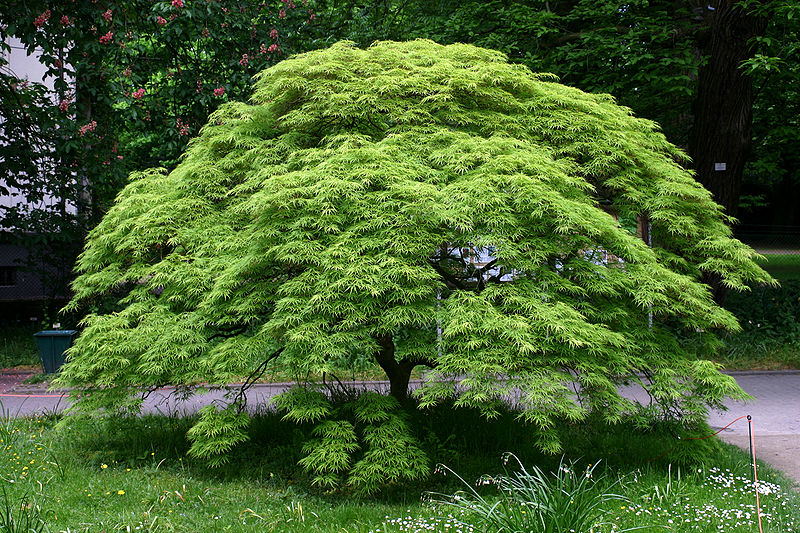This is the first half of a two part series on Japanese maple. The following examines the tree’s developmental traits, distribution and habitat, longevity, height, leaves, twigs, flowers, fruit, seed production, root development, and ideal soil conditions.
Introduction
Japanese maple (Acer palmatum), also called smooth Japanese maple, or mountain maple, is a species of woody plant indigenous to Japan, China, Korea, eastern Mongolia, Taiwan, and southeast Russia. Due to its graceful habit, and striking foliage, Japanese maple has become a staple in many landscapes and gardens. It can also be found growing as an understory plant in shady woodlands. In Europe, the first specimen of Japanese maple reached England in 1820. It was named Acer palmatum by the Swedish botanist Carl Peter Thunberg, reflecting the hand-like shape of its leaves. Many different cultivars of Japanese maple are selected and grown worldwide for their variety of forms, leaf shapes, and colors.
Developmental Traits
Japanese maple is a small deciduous tree or large shrub with a broadly spreading crown. Crown density in Japanese maple is moderate, with branches developing in a layered, symmetrical fashion. Japanese maple may be single-stemmed, or form multiple trunks, which are joined closely at the base. Japanese maple has a rounded to broad-rounded growth habit that becomes more pronounced as the plant matures. Young trees grow at a slow to medium rate, with height increases of less than twelve inches to twenty four inches per year.
Distribution & Habitat
Japanese maple is widespread in its native habitat, which encompasses Japan, China, Korea, eastern Mongolia, Taiwan, and southeast Russia. Since the 1800’s, it has also become prevalent in Europe. It is considered a weed in New South Wales, and other parts of Australia. Over the years, Japanese maple has been introduced to, and naturalized in the eastern United States, Hawaii, Central America, Canada, and New Zealand. In the United States, it is used as an ornamental plant in zones 5 through 8.
Longevity
Japanese maples that grow in ideal sites, and sustain their vigor may live for over one hundred years. However, depending on a number of environmental and cultural factors, the lifespan of Japanese maple may vary considerably. Factors such as standing water, poor quality soil, periods of drought, diseases, insect infestations, and improper planting or pruning can reduce the lifespan of Japanese maples.
Height
Japanese maple typically attains a height of 15 to 25 feet, with a spread of around 10 to 20 feet at maturity. Outliers may reach heights of up to 55 feet. Japanese maple cultivars are more varied, ranging between 4 and 30 feet in height, depending on the selection.
Leaves
Japanese maple produces attractive, reddish-purple foliage in spring and fall. In summer, the leaf color is often green. Leaves of the species are oppositely arranged. Each leaf has five or seven acutely pointed lobes that extend symmetrically from a central point. Occasionally, leaves may form up to nine lobes. Leaves are two to five inches long and wide, with serrated margins. They emerge in spring, turning a vibrant green in summer. Leaves transition to orange, red, purple, or yellow in fall.
Twigs
Twigs are red, with green and red glabrous bark. The terminal buds are usually absent.
Bark
The bark of Japanese maple ranges from green to shades of gray and brown. Some Japanese maple cultivars may exhibit a distinct bark color. For example, the ‘Bloodgood’ cultivar displays black and red bark, while the ‘Sango Kaku’ cultivar has pink coloration.
Flowers
Flowers emerge from April to June. Small, reddish-purple flowers are borne in stalked umbels. Individual flowers have five red or purple sepals, and five white petals.
Fruit
Japanese maple yields winged fruit called samaras. Samaras are elongated, ranging from ½ inch to just over one inch in length. They are joined in pairs. Samaras are green to reddish-green, and have a hard, dry exterior. Samara wings extend from ¼ to 3/8 of an inch long. Each samara contains a tiny seed. Samaras ripen between September and October. During this period, they drop from the plant, and are disseminated by the wind, landing in various locations.
Seed Production
The seeds of Japanese maple are contained in the plant’s fruit. In fall, the fruit ripens, and is distributed across landscapes and forests. The seeds lie dormant over the winter, then germinate as soon as temperatures warm in spring. This process is referred to as stratification. Japanese maple can display considerable genetic variation, with seedlings from the same parent tree often exhibiting differences in leaf size, shape, and color. The overall form of the plant may range from upright to weeping.
Root Development
Most Japanese maples have shallow fibrous root systems. The roots are not highly competitive with other plants. As such, they may be encroached upon, or displaced by aggressive plants and grasses. Japanese maple roots grow quickly through friable soil. Compacted soil hinders the spread of roots, and may stunt plant growth. Because the roots develop in the upper layers of the soil, they should be covered with a thick layer of organic mulch. Otherwise, the soil environment can quickly become sapped of moisture. Flooding conditions can promote root rot, which effectively suffocates the roots, causing them to die back.
Soil and Topography
Japanese maple can grow in acidic, loamy, moist, rich, silty, well-drained, and clay soils. It prefers moist, well-drained soil conditions, but has some drought tolerance. It can also thrive in slightly acidic, sandy, well-drained loam with a sufficient amount of organic matter. Japanese maple should be watered during dry periods, with the soil remaining consistently moist. More established trees are less susceptible to drought. Japanese maple will not tolerate wet, dry, or alkaline conditions.
Additional Resources
https://www.arborday.org/TREES/treeguide/TreeDetail.cfm?ItemID=866
http://edis.ifas.ufl.edu/st023
Photo courtesy of Rüdiger Wölk, Münster, and is available for reuse under the Creative Commons Attribution-Share Alike 2.5 Generic license.


